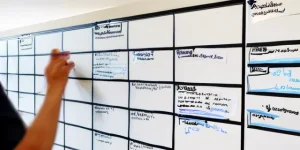Introduction
In the dynamic landscape of modern business, project management contractors play a pivotal role in ensuring the successful execution of various projects across different sectors. These professionals are not only responsible for overseeing individual projects but also for managing multiple initiatives simultaneously, which requires a unique set of skills and strategies.
Defining Project Management Contractors
Project management contractors are specialized professionals who are hired on a temporary basis to lead and manage projects for organizations. Their responsibilities often include planning, executing, and closing projects while ensuring that they meet the specified objectives, timelines, and budgets. Given their expertise, they are adept at navigating the complexities of project management, making them invaluable assets to businesses looking to optimize their project outcomes.
Increasing Demand for Project Management Contractors
The demand for project management contractors has surged in recent years, driven by the need for organizations to remain agile and responsive to market changes. As companies increasingly adopt project-based work structures, the ability to manage multiple projects efficiently has become essential. This trend is particularly evident in industries such as construction, IT, and marketing, where project management contractors are often brought in to provide specialized knowledge and to help streamline operations. The flexibility and expertise that these contractors bring allow organizations to scale their project management capabilities without the long-term commitment of hiring full-time staff.
Importance of Effective Multi-Project Management
Effective multi-project management is crucial for project management contractors, as it directly impacts the success of the projects they oversee. Juggling various projects requires not only strong organizational skills but also the ability to prioritize tasks, allocate resources efficiently, and communicate effectively with stakeholders. By mastering these skills, project management contractors can ensure that all projects are aligned with the organization’s strategic goals and are delivered on time and within budget. This capability not only enhances the contractor’s reputation but also contributes to the overall success of the organization they serve.
Understanding the Challenges of Managing Multiple Projects
Managing multiple projects simultaneously is a common scenario for project management contractors, but it comes with its own set of challenges. Here are some key difficulties that contractors often face in multi-project management:
- Time Constraints and Risk of Burnout: One of the most significant challenges is the pressure of tight deadlines. Contractors often juggle several projects at once, which can lead to overwhelming workloads. This situation increases the risk of burnout, as the constant demand for attention to multiple tasks can drain energy and focus. Effective time management strategies are essential to mitigate this risk and ensure that contractors can maintain their productivity without compromising their well-being [1][3].
- Complexity of Resource Allocation: Allocating resources effectively across various projects is another major hurdle. Contractors must ensure that each project has the necessary manpower, materials, and budget to succeed. This complexity is heightened when projects have overlapping timelines or require specialized skills. Misallocation can lead to delays and increased costs, making it crucial for contractors to develop a master plan that outlines resource distribution clearly [2][6].
- Communication Challenges: With multiple clients and teams involved, communication can become fragmented. Contractors must navigate different expectations, preferences, and feedback from various stakeholders, which can lead to misunderstandings and misalignment. Establishing a centralized communication strategy is vital to keep all parties informed and engaged, thereby reducing the likelihood of conflicts and ensuring smoother project execution [4][5].
- Conflicting Priorities: Contractors often face the challenge of conflicting priorities among projects. Each client may have different timelines, goals, and urgency levels, which can create tension and complicate decision-making. It is essential for contractors to prioritize tasks effectively and negotiate timelines when necessary to align project goals with client expectations. This requires a keen understanding of each project’s demands and the ability to adapt quickly to changing circumstances [2][6].
Best Practices for Juggling Multiple Projects
Managing multiple projects simultaneously can be a daunting task for project management contractors. However, implementing effective strategies can streamline the process and enhance productivity. Here are some best practices to consider:
1. Prioritization
Determining the urgency and importance of each project is crucial. Here are some techniques to help with prioritization:
- Eisenhower Matrix: This tool helps categorize tasks into four quadrants based on urgency and importance, allowing contractors to focus on what truly matters.
- MoSCoW Method: This technique divides tasks into Must have, Should have, Could have, and Won’t have categories, helping to clarify priorities and manage stakeholder expectations effectively.
2. Time Management
Effective time management is essential when juggling multiple projects. Consider the following tools and methods:
- Pomodoro Technique: This method involves working in focused bursts of 25 minutes followed by a 5-minute break, which can enhance concentration and reduce burnout.
- Time Blocking: Allocate specific blocks of time for different projects or tasks throughout the day. This approach helps maintain focus and ensures that each project receives adequate attention.
3. Task Delegation
Leveraging the strengths of your team and utilizing external resources can significantly improve project outcomes. Here’s how to effectively delegate tasks:
- Identify Team Strengths: Assess the skills and expertise of team members to assign tasks that align with their strengths, ensuring efficiency and quality.
- Utilize External Resources: Consider outsourcing certain tasks or hiring freelancers for specialized work. This can free up time for core project management responsibilities and enhance overall productivity.
4. Setting Clear Goals
Establishing clear and achievable goals is vital for project success. Implement the SMART criteria to set goals that are:
- Specific: Clearly define what needs to be accomplished.
- Measurable: Ensure that progress can be tracked and evaluated.
- Achievable: Set realistic goals that can be accomplished within the project timeline.
- Relevant: Align goals with broader project objectives and stakeholder expectations.
- Time-bound: Establish deadlines to create a sense of urgency and accountability.
By incorporating these best practices into your project management approach, contractors can effectively juggle multiple projects, ensuring that each one is managed efficiently and successfully.
Utilizing Project Management Tools
Especially for contractors juggling multiple projects, the right tools can make a significant difference in efficiency and effectiveness. Here’s an overview of popular project management software and practices that can streamline processes and enhance productivity.
Overview of Popular Project Management Software
- Trello: Trello is a user-friendly tool that utilizes boards, lists, and cards to help teams organize tasks visually. It is particularly effective for smaller projects or teams that prefer a straightforward approach to task management.
- Asana: Asana offers a more robust feature set, allowing for task assignments, due dates, and project timelines. It is ideal for teams that need to track progress across multiple projects and collaborate effectively.
- Microsoft Project: This software is designed for more complex project management needs, providing advanced features such as resource management, budgeting, and detailed reporting. It is suitable for contractors managing large-scale projects with multiple dependencies.
Benefits of Using Gantt Charts and Kanban Boards
- Gantt Charts: These charts provide a visual timeline for project tasks, allowing project managers to see the start and end dates of each task, as well as their dependencies. This visualization helps in planning and adjusting timelines effectively, ensuring that all team members are aligned on project schedules.
- Kanban Boards: Kanban boards facilitate a visual workflow management system that helps teams track progress in real-time. By moving tasks through different stages (e.g., To Do, In Progress, Done), contractors can quickly identify bottlenecks and adjust resources accordingly.
Importance of Centralized Communication Platforms
Effective communication is crucial when managing multiple projects. Centralized communication platforms such as Slack and Microsoft Teams enable project teams to collaborate seamlessly. These tools allow for:
- Real-time messaging: Teams can communicate instantly, reducing delays in decision-making.
- File sharing: Important documents can be shared and accessed easily, ensuring everyone has the latest information.
- Integration with other tools: Many communication platforms integrate with project management software, creating a cohesive workflow.
How Automation Tools Can Save Time and Reduce Manual Tasks
Automation tools can significantly enhance productivity by minimizing repetitive tasks. For instance:
- Task Automation: Tools like Zapier can automate workflows between different applications, such as automatically updating project statuses or sending reminders for upcoming deadlines.
- Reporting Automation: Many project management tools offer automated reporting features that generate progress reports without manual input, saving time and reducing the risk of errors.
By leveraging these project management tools and practices, contractors can effectively manage multiple projects, ensuring that they meet deadlines and maintain high-quality standards. Implementing the right software and strategies not only streamlines processes but also enhances team collaboration and project visibility, ultimately leading to successful project outcomes.
Effective Communication Strategies
Particularly for contractors juggling multiple projects, effective communication is paramount. Here are some best practices to enhance communication strategies in multi-project environments:
- Establish Regular Check-Ins and Updates: It is crucial to set up consistent meetings with both clients and team members. Regular check-ins help in identifying potential issues early and ensure that everyone is aligned on project goals and timelines. This practice fosters a sense of accountability and keeps all parties engaged throughout the project lifecycle [4][8].
- Utilize Status Reports: Implementing structured status reports is an effective way to keep stakeholders informed about the progress of various projects. These reports should highlight key milestones, upcoming tasks, and any challenges faced. By providing a clear overview, stakeholders can make informed decisions and adjustments as necessary [3][6].
- Encourage Open Communication: Creating an environment where team members and clients feel comfortable voicing their concerns is essential. Open communication allows for the early identification of potential issues, enabling proactive problem-solving. This approach not only enhances team dynamics but also builds trust with clients [1][9].
- Adapt Communication Styles: Different stakeholders may have varying preferences for communication. It is important for project management contractors to adapt their communication styles to suit these preferences. Whether it’s through formal presentations, casual discussions, or written updates, tailoring the approach can lead to more effective interactions and better project outcomes [2][7].
By implementing these communication strategies, project management contractors can effectively manage multiple projects, ensuring that all stakeholders remain informed and engaged, ultimately leading to successful project delivery.
Monitoring and Evaluating Progress
Effective monitoring and evaluation are crucial for project management contractors who juggle multiple projects simultaneously. Here are some best practices to ensure that you track project progress effectively:
- Setting Benchmarks and KPIs: Establish clear benchmarks and Key Performance Indicators (KPIs) for each project at the outset. These metrics will serve as a reference point to measure progress and success. By defining what success looks like early on, you can better assess whether projects are on track and identify areas needing attention.
- Regularly Reviewing Project Timelines and Deliverables: Consistent review of project timelines and deliverables is essential. Schedule regular check-ins to assess whether milestones are being met and if the project is adhering to its timeline. This proactive approach allows you to identify potential delays early and take corrective actions before they escalate.
- Adjusting Strategies Based on Project Performance and Stakeholder Feedback: Flexibility is key in project management. Be prepared to adjust your strategies based on the performance of each project and the feedback from stakeholders. Regularly solicit input from team members and clients to understand their perspectives and make informed decisions that enhance project outcomes.
- Using Retrospective Meetings to Learn from Completed Projects: After completing a project, conduct retrospective meetings to evaluate what worked well and what could be improved. This reflective practice not only helps in recognizing successes but also in identifying lessons learned that can be applied to future projects. By fostering a culture of continuous improvement, you can enhance your project management practices over time.
By implementing these strategies, project management contractors can effectively monitor and evaluate progress across multiple projects, ensuring that they meet their goals and deliver value to their clients.
Conclusion
Particularly for contractors, the ability to effectively juggle multiple projects is not just a skill but a necessity. As we have explored, managing several projects simultaneously requires a strategic approach that encompasses prioritization, clear communication, and the use of appropriate tools. Here are the key takeaways:
- Importance of Effective Multi-Project Management: For contractors, the success of managing multiple projects hinges on the ability to prioritize tasks based on their impact on overall business goals and deadlines. This ensures that resources are allocated efficiently and that each project receives the attention it deserves. Effective multi-project management not only enhances productivity but also improves client satisfaction and project outcomes.
- Adoption of Strategies and Tools: We encourage you to implement the strategies discussed throughout this blog, such as utilizing project management software, setting clear objectives, and maintaining organized documentation. These tools can streamline your processes, facilitate better communication among team members, and ultimately lead to more successful project completions.
By embracing these best practices, project management contractors can enhance their efficiency and effectiveness, ensuring that they not only meet but exceed client expectations in a competitive landscape.
Find out more about Shaun Stoltz https://www.shaunstoltz.com/about/.
This post was written by an AI and reviewed/edited by a human.



